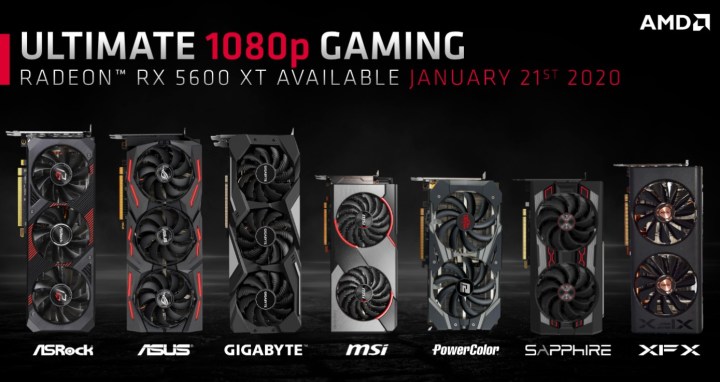This story is part of our continuing coverage of CES 2020, including tech and gadgets from the showroom floor.
When you look at any recent Steam survey, the GTX 1060 dominates the list. That 3-year-old Nvidia GPU clearly has hit a sweet spot between performance and price for 1080p gaming over the years.
AMD is well aware of this, and that audience is the exact target for the new Radeon RX 5600 XT. The company announced this new graphics card at its CES press conference this week, and followed up with some additional details in a later briefing.

AMD is right to go after the GTX 1060. Most gamers still play at a 1080p resolution, especially in e-sports titles where framerate is paramount. While the RX 5500 XT (ranging between $169 and $199) is also meant for 1080p gaming, you won’t always be able to play at max settings — at least, not if you expect framerates of over 60 frames per second.
Like the other 5000-series Radeon RX cards, the 5600 XT is based on the new RDNA 7nm architecture. AMD boasts huge increases over its predecessor, the RX 590, in two specific categories: Performance and power consumption. Performance is 42% and power is down 33%, which is far larger than a standard generational increase.
But that’s not too surprising. The bigger leap is the advantage the 5600 XT has over Nvidia’s GTX 1660 Ti. AMD claims its new GPU is, on average, is 20% faster in AAA games and 10% faster in esports titles. This an important comparison to make, as the two cards line up perfectly at $279. In fact, in response to AMD’s announcement, there are new versions of the RTX 2060 with prices dropped all the way to $300. That’s $50 cheaper than its original price.
The original 6GB GTX 1060 fell in a similar price point as the 5600 XT, which is no doubt a large reason why it was so successful. AMD says that although it’s had competitive solutions above the GTX 1060 and below it (such as the Vega 64 and Vega 56), it never had a direct competitor.

Comparing the 5600 XT side-by-side with the 5500 XT might make you scratch your head at first glance. The 5600 XT has a lower clock speed and includes less memory than the 5500 XT, which comes in both 4GB and 8GB models.
But AMD says what really makes the 5600 XT a step up is the memory bandwidth, which is 29% up from the 224 GB/s of the 5500 XT and higher than the GTX 1660 Ti. This likely a big part of why it seems to outperform the 1660 Ti across the board.
We won’t know for sure if the 5600 XT is a better value than the GTX 1660 Ti until we test it out. But judging from the specs and price alone, the 5600 XT might be the most compelling AMD graphics card purchase yet.
The card goes on sale on January 21 worldwide, starting at $279. AMD is not selling a reference card, but it says it has the full support of its third-party manufacturers on day one.
Follow our live blog for more CES news and announcements.
Editors' Recommendations
- Nvidia is the ‘GPU cartel,’ says former AMD Radeon manager
- AMD’s RX 7600 XT might be dead on arrival — but there’s a catch
- Here’s how AMD counters Nvidia’s big RTX Super launch
- Why AMD’s biggest competitor is no longer Nvidia
- AMD has another new GPU that it says can beat the RTX 4060 Ti



